#type 2 collagen
Explore tagged Tumblr posts
Text
Top Peptides for Joint Pain: How Type 2 Collagen Peptides Help

Type 2 collagen peptides are a powerful solution for joint pain relief, supporting cartilage health and improving mobility. Derived from natural sources, they help reduce inflammation, ease discomfort, and promote long-term joint flexibility. Whether you're an athlete or dealing with age-related joint issues, these peptides offer a natural, effective way to manage pain and improve overall joint function.
For More:
0 notes
Text
0 notes
Note
Thank you so much for being open about your strong fat journey!! It looks amazing on you!!
Would you be open to sharing a sample week workout write up, or some other reference tips to create a routine? As a fellow gainer girl it would be great to have a reference that works for my body type, and I love your results!
Forgive me if you’ve already shared this, or stated that you don’t want to (if that’s the case just delete the ask)
You’re a wonderful voice in the community, thank you so much for doing all you do!!
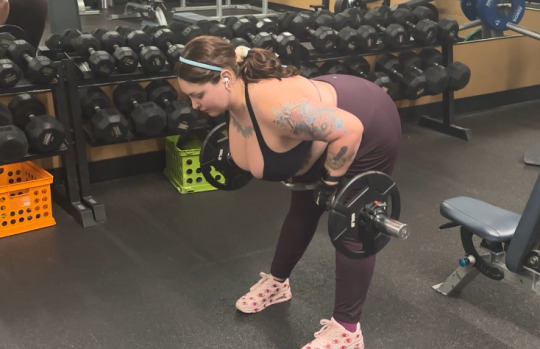
Ahh thank you!! I do have a weightlifting coach, she makes my workout plans every day but I can share my nutrition plans + my usual mobility stretches - this makes a huge difference since I was starting from being a couch potato 💕
Nutrition- 3 meals with at least 30-40g of protein each meal and minimum 2,700 calories but more is good! I like the chocolate mutant mass protein powder and put unflavored collagen peptides in everything. At least 100oz of water every day
Mobility stretches (look these up) - 12 reps of Cat Cow, Superman Arm Sweeps. 10 reps of Dynamic Thread the Needle (on each side), Kneeling Hip CARS (each side), 90/90 Hip Shifts ** my mobility stretches change slightly depending on what area I’m working out
At the gym - 4 x 6-10 reps deadlift on smith machine, 3 x 6-12 dumbbell hammer curls, 3 x 8-12 dumbbell Romanian deadlifts (RDLs), 3 x 6-12 cable machine lat pulldown, 2 x 15 each side mini band standing glute hyperextension (one foot on a riser while the other leg extends), 2 x 20 hip abductions (usually there’s a machine for these)
If you’re new to lifting the first number is the number of sets - take a minute to rest between sets or even a bit longer if needed. Second number is the range of reps you do. When researching these I would look up the right tempo for eccentric/concentric muscle contractions because that can really maximize the efficacy. I usually do a practice set with as little weight as possible before the actual set of each new exercise to make sure my form is good, bad form can cause sprains, imbalances or soreness.
I finish my weightlifting with some cooldown stretches - today it’s 60 secof wide leg oblique stretching, 60 sec childs pose lat stretch, 60 sec prone cross over leg glute stretch
~~~~~
Monday - Friday I rotate through different muscle groups so I just shared my Monday routine (pull day!) and my coach tailors it to my personal goals as well. There’s a lot of good weightlifting programs online for free! I don’t do an ounce of cardio either, only strength training.
Thank you for your kind words, I hope this sparks interest in anyone else who may wanna try getting strong. I have a membership to a cheap 24/7 local gym because when I first started I was kinda shy to be watched as I figured out my form and all that 🤣 places like that are good for beginners
193 notes
·
View notes
Text
Wound Care
Ok so, take this with a BIG grain of salt, because I may be a medical doctor BUT you need to know how much wound care training we get in medical school: none. Zip. Zilch. There may be medical schools where you do, but mine wasn't a bozo factory and there was NO wound care training. Everything I know I learned from one of several sources: an intensive 2-day wound care course I did in residency (highly recommend), the local Home Health wound care nurse (highly recommend), a completely batshit insane old white male doctor who started our learning sessions by yelling Vietnam War stories at me (do not recommend), a hospital wound care nurse (highly recommend), and experience (oh god do not recommend).
The first thing you need to know is that wound healing varies dramatically across the course of a lifespan. Kids? Kids will heal. If they don't, get their ass to a pediatrician because there's something genetic going on. Young adults will heal. Middle-aged adults will heal. You know who doesn't heal for shit? The elderly, and people with severe illnesses, and people with uncontrolled type II diabetes.
Your body needs several things in order to heal. It needs macronutrients, so you need to be able to EAT protein, fat, and carbs. If you are on total parenteral nutrition, aka TPN, aka IV nutrition, you are going to be worse at healing. If you are starving yourself, you are going to be worse at healing. If your body is desperately funneling all the calories you take in to surviving your COPD or cancer, you are going to be worse at healing.
It also needs micronutrients. If your diet sucks, you won't heal. Take a multivitamin once in a while.
There are two CRITICAL skin components to healing: collagen and elastin. Guess what we stop making as we age. Promoting collagen isn't just good for "anti-aging," it's good for NOT ripping your skin apart. Taking oral collagen is probably bullshit because your body is going to have to disassemble it to get it across the intestinal membranes to absorb, but it's also harmless, and if your diet REALLY sucks, who knows. Give it a try. Collagen is made of amino acids; think protein.
Another absolutely crucial component is blood flow. As people age, they start to develop cholesterol plaques lining arteries that eventually pick up calcium deposits. This makes blood vessels less elastic, which is a problem, but eventually also blocks them off, which is a much bigger problem. If someone has the major blood flow to their feet decreased by 90% by arterial stenosis, they are not going to heal for shit AND their foot's gonna hurt.
One component of blood flow I hadn't thought about before going into medicine is fluid retention. The way your body works, blood exits the heart at a very high velocity, but slows to a crawl by the time it gets into capillaries, the smallest blood vessels in the body. Water is a very small molecule and can leave the blood vessel, especially if there aren't big, negatively-charged molecules like proteins like albumin in the blood vessels to hold the water there. And we're built for this--some water is supposed to leak out of our blood vessels when it gets to real little vessels. It gets taken back up by the lymphatic system and eventually dumped back into the bloodstream at the inferior vena cava. But if you aren't making albumin--for instance, in liver failure--you may leak a LOT of fluid into the tissue, so much that your legs get swollen, tight, the skin feeling woody and strange. This isn't fixable by drainage because the fluid is everywhere, not in a single pocket we can drain. And because it puts so much pressure on the tissues of the skin, it often results in ulcers. Congestive heart failure, liver failure, kidney failure--these are all common causes of severe edema, aka swelling due to fluid in the tissues. And they're a real bitch when it comes to wound care, because we have such limited resources for getting the fluid back out, which is a necessary first step to healing.
Pressure is another common cause of wounds. Pressure forces blood out of those little capillaries, so you starve the cells normally fed by those capillaries, and they die. It's called pressure necrosis. Very sick people who can't turn themselves over--people in the ICU, people in nursing homes--are especially prone to these wounds, as are people with limited sensation; pressure wounds are common in wheelchair users who have lost some feeling in the parts of their bodies that rub against those surfaces, or diabetics who don't notice a rock in their shoe.
So, if you're trying to treat wounds, the questions to ask are these:
Why did this wound happen?
-Was it pressure? If it's pressure, you have to offload the source of the pressure or else that wound will not heal. End of story. You can put the tears of a unicorn on that thing, if you don't offload the pressure it won't heal.
-Was it fluid? If it's fluid, you have get the fluid out of the issues or else it won't heal. You can sometimes do that with diuretics, medications that cause the body to dump water through the kidneys, but that's always threading a needle because you have to get someone to a state where they still have juuuuust enough fluid inside their blood vessels to keep their organs happy, while maintaining a very slight state of dehydration so the blood vessels suck water back in from the tissues. You can use compression stockings to squeeze fluid back into the vessels, but if they have arterial insufficiency and not just venous insufficiency, you can accidentally then cause pressure injury. The safest option is using gravity: prop the feet up above the level of the heart, wherever the heart is at, at that moment, and gravity will pull fluid back down out of the legs. Super boring though. Patients hate it. Not as much as they hate compression stockings.
-Was it a skin tear because the skin is very fragile? This is extremely common in the elderly, because they're not making collagen and elastin, necessary to repairing skin. If this is the case, make sure they're actually getting enough nutrition--as people get into their 80s and 90s, their appetites often change and diminish, especially if they're struggling with dementia. And think about just wrapping them in bubble wrap. Remove things with sharp edges from their environments. I have seen the WORST skin tears from solid wood or metal furniture with sharp edges. Get rid of throw rugs and other tripping hazards. I had somebody last week who tried to a clear a baby gate and damn near destroyed their artificial hip.
The next critical question: why isn't it healing?
-Are you getting enough nutrients? Both macro and micro?
-Are you elderly?
-Are you ill?
-Do you have a genetic disorder of collagen formation?
Fix why it's not healing and almost anything will heal. If you're diabetic, find a medication regimen that improves your sugars and stick to it. If you're anorexic, get treatment for your eating disorder. If you have congestive heart failure, work with your doctor on your fluid balance. Wear the damn pressure stockings. Prop up your feet.
If, after those two unskippable questions are done, you want to do something to the wound--apply a dressing, do a treatment--that's a whole other kettle of fish. I'll write that later. The dryer just sang me its little song and I need to put away the laundry.
792 notes
·
View notes
Text
It's big, it's strong, its scaly, it's this week's Wet Beast Wednesday topic! An arapaima, also known as a pirarucu or paiche, is any of four species of fish in the genus Arapaima in the order of bony-tongued fish. There is som ongoing debate about the classification of the species, so to keep thing simple, I'm going to use the most common species names of Arapaima gigas (the type species and most well known, and the one with the most confusion about its classification), Arapaima agassizii, Arapaima leptosoma, and Arapaima mapae. Because A. gigas is the most well-studied of the species, unless I say otherwise you can assume everything I say in this post applies to it.

(image: an arapaima)
Arapaimas are bony fish that retain several primitive traits, causing them to sometimes be identified as "living fossils". They are most notable for their size, with A. gigas being a contender for the largest freshwater fish in the world. The maximum recorded size for one was 3.7 meters (10 ft) and 200 kg (400 lbs), but most get to around 2 meters (6.6 ft) long and 200 kg (440 lbs). That average length is decreasing as overfishing of the largest individuals is resulting in a selective pressure for smaller sizes. In addition to their size, they are extremely strong and can move fast if needed. Arapaima are fully capable of leaping out of the water if disturbed or they feel their current pond in unsuitable. Because of their strength, specimens in captivity must be handled with care as they can easy break bones if they slap someone. They live in rivers and lakes in South America, where they are often the top predators.

(image: several anglers with an arapaima)
Arapaimas are obligate air-breathers and will drown if they can't get to the surface to breathe. This is accomplished with a specialized swim bladder. The swim bladder is filled with highly vascularized tissue, letting it act like a lung. This pseudo-lung opens into the mouth using a modified gill arch known as the labyrinth organ. Arapaima gills are too small to sustain them, but they can supplement their oxygen intake with the gills. Juveniles are born exclusively using their gills and transition into air-breathers shortly after hatching. Arapaimas can survive up to a full day out of the water. They typically surface to gulp in air every 15-20 minutes. Breathing makes a loud gulping sound that anglers use to target them.
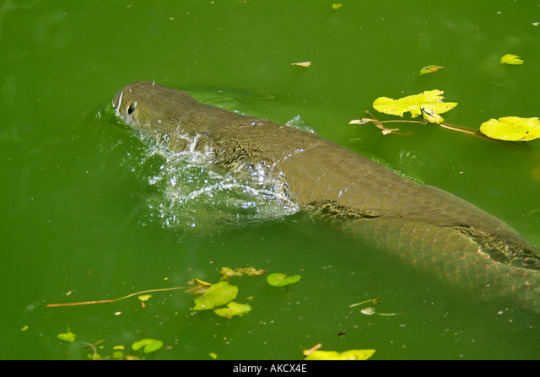
(image: an arapaima at the surface)
Because of their ability to breathe air, arapaimas are top predators in low-oxygen environments. Non-air breathing fish are forced to slow down in water with low levels of dissolved oxygen as they can't get enough oxygen through their gills. Since Arapaimas breathe air, they can easily chase down lethargic smaller fish. They are especially potent predators during the low season, when water levels lower. A combination of rotting vegetation reducing oxygen levels and ponds getting cut off from rivers and losing a supply of oxygen lets the arapaima reign supreme. Arapaimas are primarily predators that feed on smaller fish, though they will hunt other types of animals and eat fruits and seeds. Even land animals aren't safe as arapaimas have been known to launch themselves out of the water to catch animals near the shore. A combination of sharp teeth and their bony tongues are used to debilitate prey.
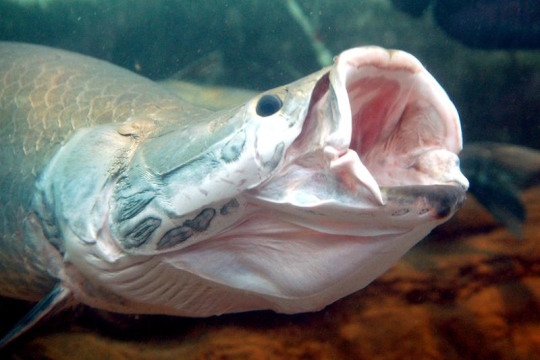
(image: an arapaima with its mouth open)
Not content with powerleveling their attack stat, arapaimas also have excellent defense. Their scales have been compared to bullet proof vests. Each has a hard, mineralized outer layer over multiple layers of collagen fibers. These layers are all oriented at an angle to each other to provide extra strength. This orientation of layers is called a Bouligand-type arrangement and is similar to how plywood is assembled. The harder outer layers and flexible inner layers work together to allow for both strength and flexibility. These scales help provide protection form large predators such as caiman and small threats like biting piranha. They also like provide protection from other arapaima, as the fish are aggressive and will fight each other.

(image: a diagram showing the composition of arapaima scales. source)
You probably wouldn't expect a swimming tank of an animal to be a good parent, but you'd be wrong. Arapaimas work together in mated pairs to build nests for their eggs, then cooperate to guard the nest. Once the eggs hatch, the male will practice mouth brooding, keeping his young safe in his mouth. The female will also help by patrolling the area around the male to ward off predators. They secrete pheromones from their heads to ensure the young don't swim too far away. Eggs are laid either in in the low season or as water levels are starting to rise, ensuring that the young become independent during the high season.

(Image: baby arapaimas)
Arapaima are classified as "data deficient" by the IUCN. This means there isn't enough data to properly assess their conservation needs. They are known to be threatened by overfishing. Arapaima make up a large part of the diet of many South American populations. Habitat loss and pollution are also believed to threaten them. They have been introduced to many areas out of their native range and are an invasive species in placed like Florida, Malaysia, and India.
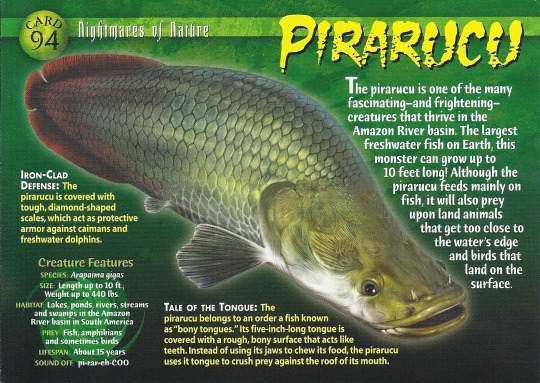
Does anyone else remember these cards? (image: the arapaima card from Weird n' Wild Creatures)
#wet beast wednesday#fishblr#fish#biology#zoology#ecology#animals#aquatic biology#animal facts#absolute unit#arapaima#pirarucu#paiche
1K notes
·
View notes
Text
lets talk skincare⋆.ೃ࿔*:・🎀

disclaimer i am NOT a dermatologist so to create this post i did LOTS of research and i'll link all of my sources at the end of the post. i just wanted to kind of put everything that i found in here so i hope its helpful 💕🗒️
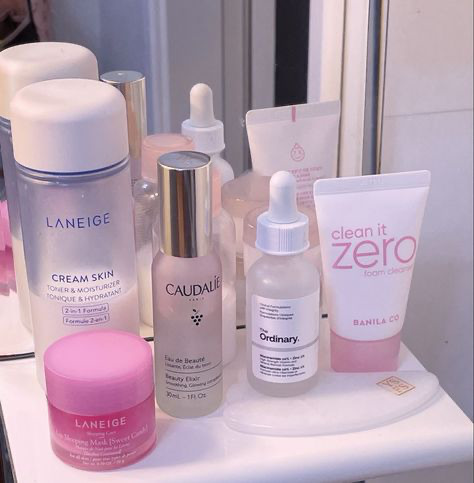
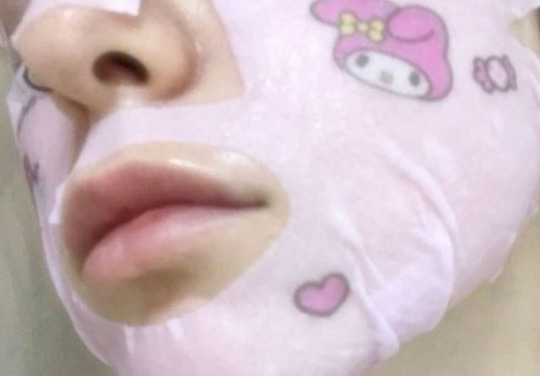
HOW TO DETERMINE UR SKIN TYPE ;
wash ur face with a gentle cleanser, pat dry and wait for about 30 minutes. if ur skin appears shiny throughout then u have oily skin, if ur skin appears tight/flaky then u have dry skin.
if u notice a slight shine on your nose and forehead then you have normal skin. if you have a combination skin type, then the skin will get oily around the t-zone.
INGREDIENTS TO LOOK FOR ;
for skin with acne -> salicylic acid, benzoyl peroxide, sulfur and mandelic acid.
for dry skin -> lactic acid, hyaluronic acid, ceramides and glycerin.
for pigmented skin -> mandelic acid, niacinamide, vitamin C, and arbutin.
INGREDIENTS THAT U SHOULD NOT MIX ;
mixing retinol and vitamin C causes irritation, mixing vitamin C and glycolic acid results in over-exfoliation, mixing AHA and retinol causes extreme dryness.
INGREDIENTS THAT U SHOULD MIX ;
hyaluronic acid + ceramides = repairing skin barrier. niacinimide + salicylic acid = healing acne. retinol + niacinimide = collagen production.
GLOWY SKIN TIPS ;
use a cleansing balm to cleanse ur face to remove all the impurities from ur skin
use serums to hydrate ur skin
lather on moisturizer, dont put too much to the point where ur skin cannot produce its own oils, but you MUST moisturize
apply sunscreen everyday, not only on ur face but also on ur neck and hands
face masks 1-2x a week
get enough sleep, drink enough water, and steer clear of overly processed foods
SKINCARE DOESNT STOP AT UR CHIN ;
its important to take care of the skin on ur neck for SO many reasons because skincare doesnt stop at ur chin. ur neck reflects the first signs of aging, and its most susceptible to sun damage so show it some love!
use the same products that u use on ur face on ur neck also, moisturize ur neck and always apply sunscreen, lastly, use some retinol to build collagen.
HOW TO APPLY RETINOL ;
when applying retinol, use a pea sized amount. avoid application around ur eyes and the openings in ur nose, and use retinol in ur night skincare routine only.
HOW OFTEN TO USE SKINCARE ;
retinol should be used nightly (1-2x a week for beginners). hyaluronic acid should be used (2x a day). salicylic acid should be used (1-2x a week). sunscreen should be applied daily, no need to apply it at night and if u can, you should reapply it every 2-3 hours. vitamin C (1x a day in the morning).
SERUMS FOR UR SKIN-TYPE ;
for oily skin use -> salicylic acid, niacinimide and mandelic acid.
for dry skin use -> hyaluronic acid, ceramides and lactic acid.
for normal skin use -> vitamin C, glycolic acid, and retinol.
for aging skin use -> peptides, retinol and vitamin C.
for acne prone skin use -> salicylic acid, retinol, and niacinimde.
for combination skin use -> mandelic acid, niacinimide, and glycolic acid.
WHAT TYPE OF FACEMASK IS BEST FOR YOU ;
cream masks are good for all skin-types and it soothes and moisturizes. clay masks are good for oily or acne prone skin and it absorbs oil and controls shine. charcoal masks are good for oily or acne prone skin, and it deep cleanses and unclogs.
sheet masks are good for all skin-types, it nourishes and hydrates. enzyme masks are good for all skin-types and it gently exfoliates and brightens the skin. bubble masks are good for all skin-types and it hydrates and soothes.
gel masks are good for all skin-types and it provides a cooling effect. exfoliating masks are good for all skin-types BUT if u have sensitive skin then exfoliating masks are not for you. exfoliating masks remove dead skin cells and debris.
HOW TO LAYER UR SKINCARE ;
in the morning (cleanser + toner + hydrating serum + vitamin c + moisturizer + sunscreen) in the evening (double cleanse + toner + hydrating serum + retinol + moisturizer)
#advice#honeytonedhottie⭐️#it girl#becoming that girl#self care#that girl#self love#it girl energy#dream girl tips#dream girl#dream life#tips#guide#hyper femininity#girl blogging#hyper feminine#skincare#skincare routine#skincare guide#pampered princess#diva#luxurious#glamor#doll
396 notes
·
View notes
Text
Strategies for enhancing collagen synthesis
A biochemical perspective
Collagen, the most abundant protein in the human body, is essential for maintaining the structural integrity of skin, bones, cartilage, and connective tissues. Its production naturally declines with age, leading to wrinkles, joint pain, and other signs of aging. This article explores specific, scientifically-backed methods to boost collagen production, with a particular focus on the biochemical processes involved.


1. Bone broth
A DIRECT SOURCE OF COLLAGEN PRECURSORS
Bone broth is a direct dietary source of collagen. This nutrient-dense liquid, derived from simmering animal bones and connective tissues, is rich in collagen, gelatin, amino acids (such as glycine, proline, and hydroxyproline), and minerals. When ingested, collagen from bone broth is broken down into its constituent amino acids, which serve as building blocks for collagen synthesis in the body.
Biochemical mechanism
The collagen in bone broth is primarily composed of type I, II, and III collagen. Upon ingestion, it undergoes enzymatic hydrolysis in the stomach and intestines, producing peptides that are absorbed into the bloodstream. These peptides, especially glycine and proline, are crucial for collagen synthesis. Glycine provides the basic structural unit, while proline and hydroxyproline confer stability to the collagen triple helix by facilitating hydrogen bonding.
Scientific support
Research suggests that consuming bone broth can increase the levels of collagen-derived peptides in the bloodstream, which may be utilized by fibroblasts in the skin and other tissues to enhance collagen synthesis. A study published in Nutrients found that participants who consumed collagen peptides from bone broth showed improvements in skin elasticity and hydration, indicative of enhanced collagen production.


2. Vitamin C
THE COFACTOR FOR COLLAGEN SYNTHESIS
Vitamin C (ascorbic acid) plays a critical role in collagen synthesis as a cofactor for the enzymes prolyl hydroxylase and lysyl hydroxylase. These enzymes are responsible for stabilizing the collagen molecule by hydroxylating proline and lysine residues, which are essential for the formation of stable collagen fibrils.
Biochemical mechanism
Vitamin C donates electrons to the iron-containing active sites of prolyl and lysyl hydroxylase enzymes, converting Fe3+ back to Fe2+ and thereby maintaining enzyme activity. This hydroxylation process enhances the thermal stability of the collagen triple helix and is essential for the secretion of mature collagen from fibroblasts.
Scientific support
Studies have demonstrated that vitamin C supplementation can significantly increase collagen production. For example, a study published in The American Journal of Clinical Nutrition showed that daily supplementation with vitamin C led to higher levels of procollagen mRNA in the skin, indicative of upregulated collagen synthesis.


3. Jumping rope
STIMULATING COLLAGEN VIA MECHANICAL STRESS
Exercise, particularly high-impact activities like jumping rope, has been shown to stimulate collagen synthesis in connective tissues. The mechanical loading experienced during jumping rope promotes the production of type I collagen in tendons and type II collagen in cartilage.
Biochemical mechanism
The mechanical stress from jumping rope induces microtrauma in collagen fibers, which stimulates fibroblasts and chondrocytes to upregulate collagen synthesis. This process is mediated by the mechanotransduction pathway, where mechanical forces are converted into biochemical signals, leading to the activation of signaling molecules such as integrins and focal adhesion kinase (FAK). These signals enhance the transcription of collagen genes (COL1A1, COL2A1) and increase the production of growth factors like TGF-β (transforming growth factor-beta), which further stimulates collagen synthesis.
Scientific support
Research in sports medicine indicates that regular mechanical loading, such as through jumping rope, leads to adaptive remodeling of collagenous tissues. A study published in The Journal of Strength and Conditioning Research found that athletes who engaged in high-impact exercise had significantly higher collagen content in their tendons compared to those who did not.


4. Nettle (Urtica dioica)
AN HERB RICH IN ESSENTIAL COLLAGEN-BUILDING MINERALS
Nettle is an herb rich in silicon, sulfur, and other minerals essential for collagen synthesis. This plant is traditionally used in infusions and teas to improve the health of skin, nails, and hair, indirectly contributing to collagen production.
Biochemical mechanism
The silicon present in nettle plays a key role in cross-linking collagen, enhancing the strength and stability of collagen fibers. Sulfur is involved in protein synthesis, including key enzymes in collagen production. Nettle is also rich in antioxidants that protect collagen from oxidative damage.
Scientific support
Studies suggest that supplementation with nettle can improve collagen quality. A study published in The Journal of Herbal Medicine found that using nettle-based supplements led to increased collagen synthesis and improved skin elasticity.


5. Green tea
A POWERFUL ANTIOXIDANT FOR COLLAGEN PROTECTION
Green tea is rich in catechins, particularly epigallocatechin gallate (EGCG), which has potent antioxidant properties. These compounds not only protect existing collagen from oxidative damage but may also stimulate the production of new collagen.
Biochemical mechanism
EGCG in green tea inhibits the activity of matrix metalloproteinases (MMPs) that degrade collagen in the skin. Additionally, EGCG has been shown to upregulate the expression of collagen genes and enhance the proliferation of fibroblasts.
Scientific support
A study published in The Journal of Nutritional Biochemistry demonstrated that green tea catechins can prevent collagen degradation and stimulate new collagen production in the skin, particularly in response to UV exposure. This makes green tea an excellent natural choice for promoting collagen health.
#it girl#that girl#clean girl#hyper feminine#becoming that girl#glow up tips#healthy girl#pink pilates girl#this is what makes us girls#weight loss#collagen#skincare#natural beuty#beauty tips#feminine beauty#beauty treatments#stem studyblr#stem girls#stem academia#stemblr#women in stem#stem student#uni studyspo#uni studyblr#uni blogging#uni student#biochemistry#nutrition#healthy diet#healthy eating
134 notes
·
View notes
Text
Beauty Diary
Chapter 2: Building A Maintenance Routine
Let’s girl talk about how to build a maintenance routine, how to schedule, when to book appointments + understanding medical esthetic procedures.
How to Build a Routine:
Understand yourself and your beauty needs/desires. Do you want to start getting manicures? Are there any skin concerns you want to address + treat? Any enhancements you want? Are you ready to start keeping up with your hair? Once these questions are answered you can start building a routine!
Know what services can be done at a salon or at home.
Research for the best salons and spas near you
Take note of what you learn about yourself from your appointments so you know how to keep up at home. Ex.) Your skin type, curl pattern, hair porosity, ingredients that work best for you + your skin undertone.
List out what services you want done, how often you want them done and what you’re looking to achieve after each service.
Set beauty goals and plan to save for special beauty services.
Facials:
Basic facials should be done every 4-6 weeks.
When it comes to medical spa procedures they should be done at least once a month!
Here’s a short list of my favorite medical spa treatments to gain an understanding of what they are and how they benefit you.
Hydrafacial: a non invasive procedure that combines cleansing, exfoliation, extraction, hydration and antioxidant protection by removing dead skin cells and impurities while simultaneously delivering moisturizing serums into the skin. (Skin type: ALL) should be done every 4-6 weeks.
Chemical Peel: a solution applied to the face to remove dead skin cells and stimulate the growth of new cells. (Skin type: ALL. Darker skin complexions can experience post-inflammatory hyperpigmentation) should be done once a month.
Microdermabrasion: a minimally abrasive instrument is used to gently sand your skin in order to remove the thicker, uneven outer portion of skin. Best for light scarring, discoloration, sun damage and stretch marks. (Skin type: Skin prone to acne scars, age spots, unevenness, discoloration and sun damage.) should be done very 4-8 weeks.
PRP aka Vampire Facial: a procedure that involves drawing the clients blood, spinning it and injecting it through microneedling to increase collagen, reduce fine lines/wrinkles, improve moisture retention and enhance skin tone + texture. (Skin type: typically ACNE PRONE SKIN) should be done every few weeks and maintenance sessions are done 2-4 times a year.
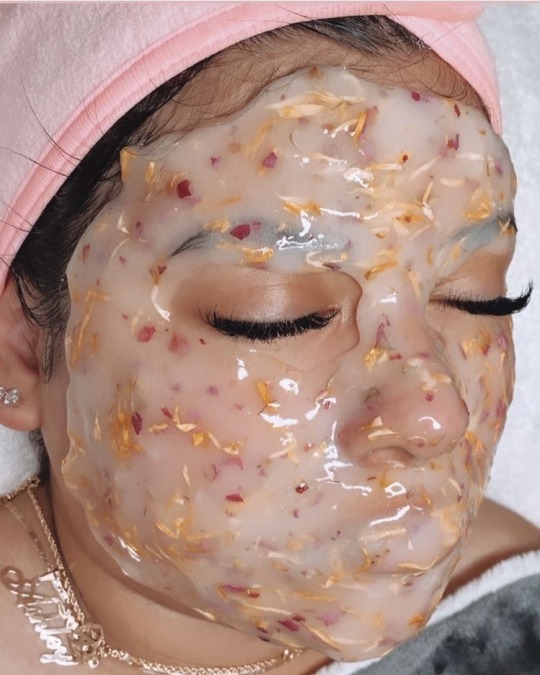

Hair Removal
There are many types of hair removal procedures to invest your time and money into. Waxing, sugaring, threading, laser hair removal and electrolysis. It’s best to go in for a hair removal service when your hair is the size of a grain of rice.
Waxing: every 2-5 weeks. face, underarms and bikini can be done every 2-3 weeks. hair length should be 1/4 of an inch.
Sugaring: every 2 weeks. hair length should be at least 1/8 of an inch.
Threading: every 2-3 weeks.
Laser Hair Removal: every 4-6 weeks done in about 4-6 treatment sessions. maintenance treatments can be done once every 6-12 months.
Electrolysis: every 2-4 weeks done in about 8-12 treatments. can take any where from 8 months, 12 months and 2 years to complete the treatment.
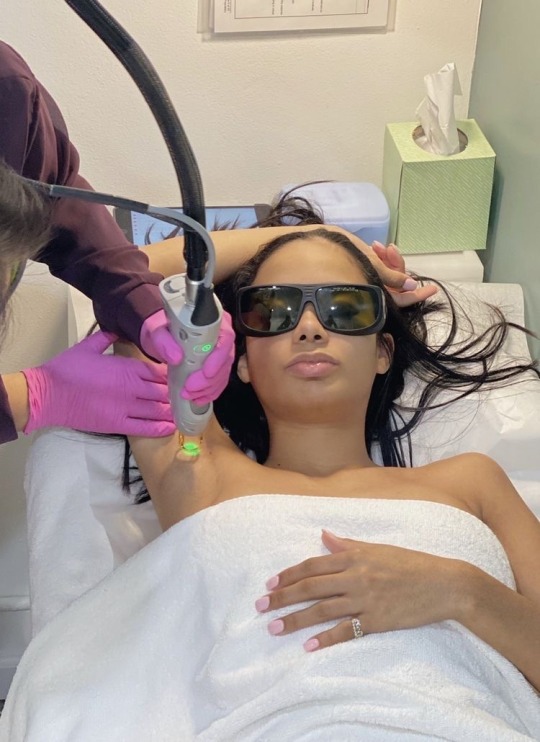
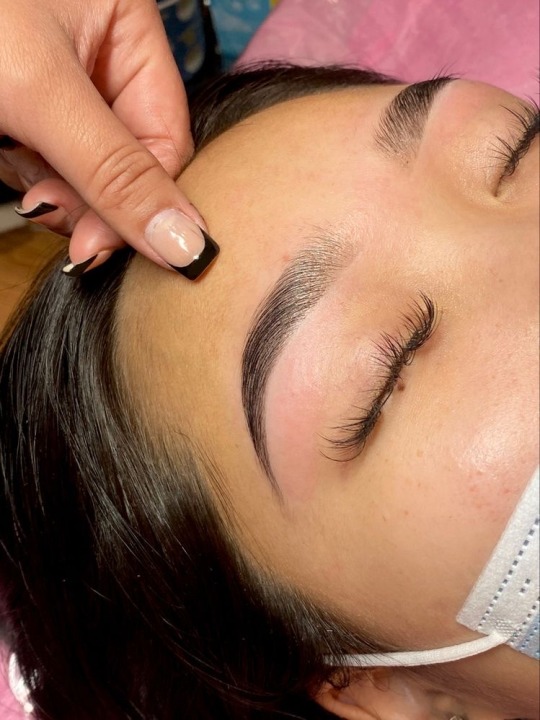
Cosmetic Injections
Cosmetic injections tend to be a yearly treatment routine. I recommend investing in packages in order to get more treatment sessions for a certain amount of money. They can also include a free treatment. Packages can be used for medical esthetic procedures such as laser hair removal packages, body contouring packages and tattoo removal packages as well.
Participating in Botox parties are also a good way to get a discount and purchase Botox packages. I used to assist hosting botox parties which included champagne, mimosas, cute desserts and discounts for clients if they brought a friend!
Botox: once every 4 months.
Lip Filler: once every 12-18 months.
Chin Filler: once every 1-5 years.
Non Surgical Rhinoplasty: once every 6 months.
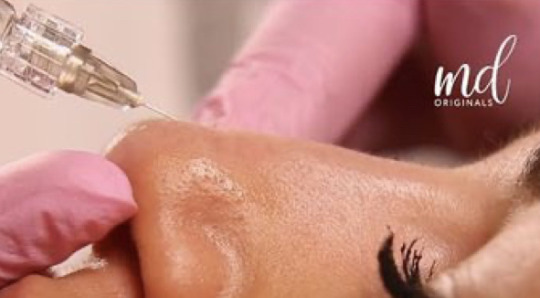
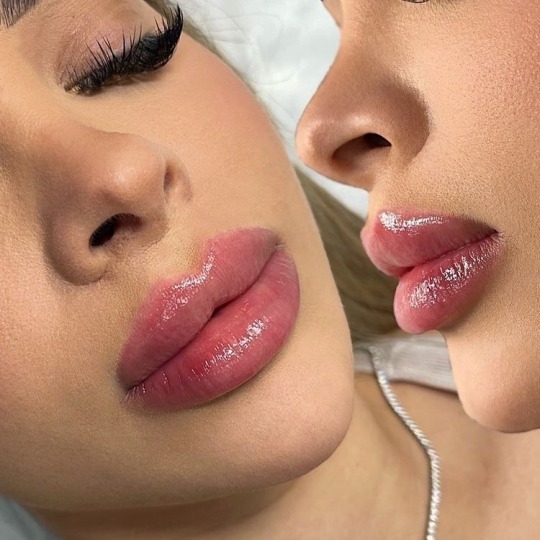
Nails
During the summer time is when I go into the nail salon more often than usual to keep my nails and toes ready for the sunshine.
Gel Manicure: every 3-4 weeks between fills.
Gel Pedicure: 2 weeks to 1 month.
Acrylic Nail Set: filled every 2-3 weeks. every 8 weeks to replace fake nails.
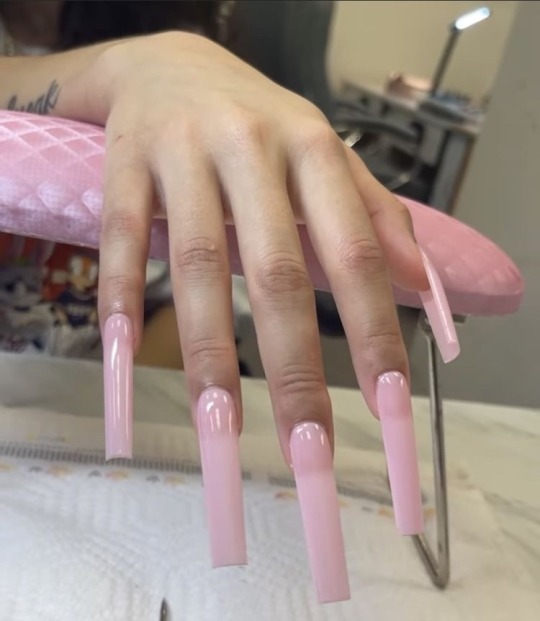
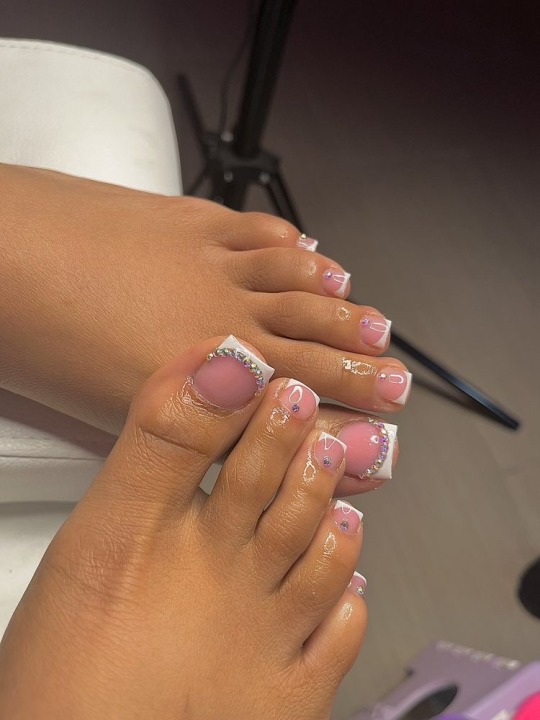
Hair
Your hair should be healthy and kept in good maintenance by using an effective salon routine.
Hair Color: every 4-6 weeks between each hair coloring session.
Haircut: every 6-8 weeks or every 3-4 months.
Extensions: glue and tape extensions every 4-8 weeks, sew-in extensions every 6-8 weeks and micro-link extensions every 2-3 months.
Wig Installations: every 1-6 weeks.


Other
Lash Extensions: every 2-3 weeks.
Lash Lift: every 6-8 weeks.
Lash Tinting: every 4-6 weeks.
Bow Tinting: every 4 weeks.
Brow Lamination: every 4-6 weeks.
Microblading: touch ups 1 or 2 times a year.
Appointment Layout:
Week 1: hydrafacial & extraction session.
Week 2: eyebrow wax & tint.
Week 3: hair cut & color.
PSA:
How often you get any procedures done depends on you, your budget, your skin, your hair, your nails, your stylist, your esthetician or your health care provider. Please build a beauty routine that fits you and your life style the best!
722 notes
·
View notes
Text
i get asked a lot if certain breast sizes or shapes are "normal" and let me tell you right now, the answer is basically always "yes"!
we only see one shape of breasts on tv (think C-D cup "HBO titties") and maybe two or three types in porn if you see porn, and maybe 3-4 types in contemporary and historical art. and this sucks because it makes everyone else feel like their boobs are weird. they're probably not weird.
because breasts are made mostly of fat, which is squishy and only partially influenced by muscle and skeletal attachments, they can be basically any size or shape, and they CHANGE more or less constantly throughout your life. they are sensitive to hormonal, environmental, body compositional and pressure-based influences. they will continue to change size and shape until you die. i have a mild collagen disorder which makes me stretchier than other people in some ways and my breasts will change shape visibly if i don't wear a bra for a day. some people's breasts are so dense they wouldnt move at all even if you kept them squished or pulled for many hours at a time. human fat and skin is SO malleable and variable and it's a big reason we're such an interesting-looking species.
this link is a little website with some pictures of SOME different shapes of breasts, and for as varied as it is, it's actually still very limited in scope. it's focused on helping people find bras that fit but you can ignore that part if you want and just get an idea of some different shapes boobs can be, in a non-porn and non-medical context. they can be even more shapes than this. this gallery is intentionally in b&w and has been contrast-balanced to make everyone about the same color but different breast shapes are strongly genetic and will pop up in different locales and lineages. your boobs will often resemble those of your relatives (but not always).
it takes a long time for breasts to reach their "adult" shape, and it happens closer to about age 25-27 for many people than 18-20. a lot of medical literature will repeat the claim that women are "physically mature" by the age of 15-18, and this just isn't really true. if you are on HRT, please keep in mind that the average cis woman can start experiencing hormonal puberty when she's 9-12, and major changes can keep occurring until she's 25 or older. I'm AFAB, and my boobs went through a final growth change when i was 27! and i started the first stages of puberty (way before my first period, which is called "menarche" [men-ARK-ee]) when i was about 9. that's not outside the bounds of normalcy at all, average age of first period is about 12.5 years, and puberty itself starts a few years before that.
some of the later Tanner stages are related to gravity as well as fat accumulation, and sometimes they require a certain period of time to "settle" the very high, pointy puberty breasts down into more adult breast shapes. this takes time. the timelines doctors give HRT patients about breast growth are really weird to me as someone who grew breasts myself. sometimes i see people on HRT get worried about their breast growth not being big enough or adult enough after only a couple years, when the average cis woman's breasts take much longer than that (remember: started age 9, finished age 27!!) to mature and settle, and i just want people to not worry too much. i post about this regularly because i want people to see it. I've heard from many trans women that their actual doctors told them that they would get most or all of their breast growth within 2-3 years. that's not true for everyone, possibly for most people.
and by the way, breasts are almost never perfectly symmetrical. they are sisters, not twins. most people have one breast that's visibly larger if you look closely, and often even if you don't look closely. many people have one breast that's even a cup size larger, or more. some people only grow one breast at all, and don't have fat tissue on the other side. sometimes you start with mostly-matched boobs but they become different over time. all these situations are "normal", in that they occur to many many people and are almost never related to health problems or functional concerns.
817 notes
·
View notes
Text
Fukuzawa and Mori with a S/O who is really into skincare.(Separate)
TW: None
Genre: Fluff

Mori
That man is an ex-doctor so he knows what ingredients work with what skin type.
He will take you to the best of the best aesthetic clinics.
If he doesn't know or has no time for skincare shopping, he will ask Kouyou to take you.
He will buy every gift set from every luxury brand for you to find out which brand works better until you've found the best one.
He will stare at you whenever you apply skincare or makeup until you ask " What's wrong with you?"
I doubt he used his own skincare but after seeing you're too stunning and elegant after the usage of skincares, he will want to use them too.
Of course, he will sneak your facial mask and put on his face telling how the facial masks are so relaxing
His favorite will be green tea with calming effect and collagen since he's in his 40
( He's getting older and he doesn't want people age shaming him in his back)🤣
At night, he and his S/O put on facial masks , lie down on the couch and have some quality time.

Fukuzawa
Unlike Mori, this man only knows shower gel, shampoo and deodorant.
He always sees his s/o applying so much liquid and oil on her face but he never knows what those are.
One day, his S/O ran for groceries and he's alone in the house, that's when he let his instructive thoughts win.
He rushed to the bedroom, picking up the pretty bottle one by one, smelling them one by one.
Finally, he decided to apply them on his face. Don't worry, he has seen you doing it every day so at least, he remembered the routine.
You came back and saw your husband sitting on the chair with a book.
( Something's wrong with him ) You thought quietly and stared at him for 2 or 3 minutes.
And then, you giggled.
"You used mine right? "
Fukuzawa didn't answer but his tomato face admitted what he did. You decided you should gife your husband.
Next day,You gifted him with a set of skincare which was released especially for middle aged men.
Now, you're even jealous of him because being 20 years younger than him, his skin is now better than yours , glowing and glowing.
#bungo stray dogs#mori ougai x reader#bsd fukuzawa#mori ougai#bsd fukuzawa x reader#fukuzawa yukichi x you#fukuzawa yukichi#bsd mori x reader#bsd x reader#bsd mori
291 notes
·
View notes
Text
Premium Type II Collagen Peptides - Boost Joint Health and Mobility

Experience enhanced joint health and mobility with our premium Type II Collagen Peptides. Specially formulated to support cartilage and connective tissue, these peptides promote flexibility and reduce discomfort. Ideal for athletes and anyone seeking joint support. Purchase now and feel the difference in your daily activities.
For More:
0 notes
Text
Say hello to a new disease-
Thwarp rot!

A parasite contracted from mossthwarp mushrooms. (top right)
This lil guy consumes fat, muscles, skin, and collagen.
Type 1: Parasite overpowers immune system, deteriorating the body, using it to spread the fungus. Ends up in death.
Type 2: Parasite fails to overtake body, often becoming too weak to grow the fungus without dying. The parasite keeps the body alive no matter what- since if the host dies, the parasite dies, and vice versa.
Victim loses ability to speak due to deterioration of vocal cords. The parasite relies heavily on protein and collagen to help form the mushrooms and continue survival.
55 notes
·
View notes
Text
Real Skincare Guide

Level 1: breakouts, non-painful, a little scarring
Minimize your skincare routine, all you need is an oil cleanser (if you wear a lot of makeup) than a good foam cleanser, moisturizer, and sunscreen. Repeat the same routine before bed just without the sunscreen.
Wear sunscreen everyday!!!
Always apply more moisturizer than you think you need.
Drink a lot of water (2-3LT)
Get consistent sleep
Take a multi vitamins to balance your hormones. I recommend the One-A-Day Woman’s Vitamins (get a real pill cause the gummies don’t have enough iron)
Work on your stress (breathe work, meditate, journal, yoga, walks, going out with friends, therapy, etc)
Look at what body oils/shampoo/conditioner you are using. Could be your akin reacting poorly to something in there.
Level 2: consistant breakouts, acne, scarring
All the stuff for Level 1 apply.
Minimize your skincare routine and than slowly add back in stuff like hydrochloric acid and retinol. Having an elaborate skincare will just make your skin worse. First, focus on healing your skin barrier.
If you are a teenager, it just might be your hormones/growing pains. It will go away eventually.
Pimple Patches work and are especially good if you are trying to stop touching your face.
Wash your pillow cases every 1-2 weeks.
Try to sleep on your back.
If you pop a pimple than apply an antibiotic ointment.
No point in using anti-aging products if you are under the age of 25. It just won’t do anything for you.
Note that if you take in a lot of nicotine you will breakout. If you smoke and you have bad skin, it probably won’t improve unless you quit or lessen the dosage.
Level 3: painful consistent breakouts/acne/scars, redness, irritability, hurts,
Go see a dermatologist!
Acne is can be a real problem. If your acne is painful seek professional help.
If Accutane is recommended, than I would do it. Based only on the experiences of my friends, I have seen great results after a couple months. There are side effects and it is not for everyone but if a professional says you should than I might consider it.
No topical treatment is going to make those scars go away. You are going to need to laser resurfacing which is like this secret treatment rich people do to clear up their skin. It is expensive but really works. Beauty brands want you to think that the right cream can clear up your skin but if you have bad scarring you are only going to see real results with laser treatments
All of the above recommendations still apply
Your acne does not take away from your beauty or your worth as a human being. Remember that acne is normal and social media is fake.

Product Recommandations:
Disclaimer: Not every product will work for every skin type. Do your research for what will be beat for you!
Korean skincare! It is reliable to buy from yesstyle or Olive young. Don’t buy on amazon. (Japanese skincare is good too)
AESTURA Atobarrier 365 Cream
Ma:nyo Pure Cleansing Oil
Ma:nyo Bifida Biome Conplex Ampoule
Beauty of Joseon (sunscreen, eye cream, and serum)
Round Lab 1025 Dokdo Cleanser and Round Lab Birch Juice Sunscreen
Torriden Serum
KAHI Multi Balm
Anything from The Ordinary
CeraVe Daily Moisturizer
CeraVe SA Face Wash Cleanser
CeraVe Acne Foam Cleanser
CeraVe Resurfacing Retinol Face Serum
La Roche Posay spot treatment and soothing balm
EltaMD sunscreen
Soon Jung brand
Laniege Toner
Royal Honey propolis Essence
Aware Lip and Eye remover
TIRTIR- Centella Foam Cleanser
KAHI wrinkle bounce collagen mist
Real Calendula Toner Hyaluronic Toner Pads
Abeille Royale double R renew and repair serum 
Tom Ford Lip Balm
Rovectin activating treatment lotion
LA MER moisturizer
PanOxyl Acne Foaming wash
#beauty#books#fashion#kate moss#lily rose depp#makeup#self love#skincare#tiktok#workout#kpop#korean#beauty tips#skincare tips#moisturizer#product recommendations
215 notes
·
View notes
Text
Our body is is naturally very good at healing. When we get injured, the first thing our body has to do is protect the wound. Platelets help clot the blood and stop your bleeding, and white blood cells work to clear debris and fight off bacterial invaders. Then the real healing begins Our white cells produce extracellular vesicles (EVs) that act as our body's "construction crews", promoting blood vessel formation and reducing inflammation as the tissue recovers.
Most of the methods we use to treat injuries to the skin involve helping out the body during the first stage- stitches to keep the wound closed and stop bleeding, antibiotics to help kill bacteria, and bandages to keep dirt and debris away from the healing wound. But a research team developed a new form of wound therapy designed to help expedite the second stage of healing.
PAINT, or portable bioactive ink for tissue healing, works not by clearing the environment to make the body's work easier, but by delivering additional EVs, or construction crews, into the body. The EVs are harvested from macrophages, a type of immune cell that digests debris and pathogens in the body. The EVs are mixed with a hydrogel for stability and then "painted" onto a wound with a 3D printing pen, forming a solid gel in about 3 minutes. Here is a video of it in action!
The EVs were tested on injured mice, and found that they significantly promoted the development of collagen fibers and accelerated the healing process. Here is an image of a simulated wound after 14 days of healing with no intervention and with 2 different concentrations of PAINT.

With more development, this technology could be instrumental to healing major wounds to the skin with minimal intervention.
#science#stem#stemblr#biology#medicine#technology#health#healthcare#science side of tumblr#scientists
161 notes
·
View notes
Text
The Basics of Skin Care
A 100 skincare tips for beginners:
Cleansing:
1. Cleanse your face twice a day.
2. Use a gentle, sulfate-free cleanser.
3. Avoid hot water, as it can strip natural oils.
4. Use a cleansing brush or washcloth for gentle exfoliation.
5. Remove makeup before bedtime.
6. Double cleanse if you wear heavy makeup.
7. Don't over-cleanse; it can lead to dryness.
Exfoliation:
8. Exfoliate 1-3 times a week, based on your skin type.
9. Choose chemical exfoliants like AHAs or BHAs.
10. Be gentle when physically exfoliating.
11. Avoid over-exfoliation to prevent irritation.
Moisturizing:
12. Use a moisturizer suitable for your skin type.
13. Apply moisturizer while your skin is slightly damp.
14. Don't forget your neck and chest.
15. Consider using a humidifier in dry climates.
Sun Protection:
16. Always wear sunscreen, even on cloudy days.
17. Use a broad-spectrum SPF of at least 30.
18. Reapply sunscreen every 2 hours.
19. Wear protective clothing and sunglasses.
20. Avoid tanning beds and excessive sun exposure.
Anti-Aging:
21. Use products with antioxidants like vitamin C.
22. Apply retinol at night for anti-aging benefits.
23. Consider peptides for collagen support.
24. Stay hydrated to maintain skin elasticity.
25. Get enough sleep for skin repair.
Hydration:
26. Drink plenty of water for overall skin health.
27. Use a hydrating serum or hyaluronic acid.
28. Avoid hot showers that can dry out your skin.
29. Limit alcohol and caffeine intake.
Acne Management:
30. Use salicylic acid for acne-prone skin.
31. Don't pop pimples; it can lead to scarring.
32. Change pillow cases regularly.
33. Maintain a balanced diet to reduce breakouts.
34. Consult a dermatologist for severe acne.
Skincare Routine:
35. Develop a consistent skincare routine.
36. Patch test new products.
37. Customize your routine based on your skin's needs.
38. Consider professional facials occasionally.
Makeup:
39. Clean makeup brushes and sponges regularly.
40. Avoid sharing makeup to prevent infections.
41. Choose non-comedogenic makeup products.
42. Remove makeup before going to bed.
Eye Care:
43. Use an eye cream to address under-eye concerns.
44. Be gentle when applying and removing eye makeup.
45. Get enough sleep to reduce under-eye puffiness.
Lifestyle:
46. Manage stress to prevent skin issues.
47. Get regular exercise for better blood flow.
48. Avoid smoking and secondhand smoke.
49. Limit alcohol consumption.
50. Eat a balanced diet rich in fruits and vegetables.
Special Treatments:
51. Use a face mask 1-2 times a week.
52. Try sheet masks for extra hydration.
53. Consider facial oils for added moisture.
54. Use a lip balm to prevent chapped lips.
Skin Conditions:
55. Consult a dermatologist for skin conditions.
56. Use products with soothing ingredients for sensitive skin.
57. Eczema-prone skin should avoid harsh products.
58. Rosacea-prone skin should use gentle, non-irritating products.
59. Psoriasis-prone skin may benefit from salicylic acid.
DIY Skincare:
60. Be cautious with DIY treatments; research first.
61. Natural ingredients like honey and aloe can be beneficial.
62. Avoid DIY recipes with harsh or abrasive ingredients.
63. Test DIY masks on a small area first.
Sleep:
64. Get 7-9 hours of sleep for skin regeneration.
65. Sleep on a silk or satin pillowcase to reduce friction.
Hands and Feet:
66. Moisturize hands and feet, especially in winter.
67. Use sunscreen on your hands to prevent age spots.
Body Skin Care:
68. Don't forget to moisturize your body.
69. Exfoliate your body regularly.
70. Take short, lukewarm showers to prevent dry skin.
Shaving:
71. Shave in the direction of hair growth.
72. Use a sharp, clean razor.
73. Apply a moisturizing shaving cream.
Hair Care:
74. Use a gentle shampoo and conditioner.
75. Avoid hot water when washing your hair.
76. Protect your hair from UV damage.
Hormonal Changes:
77. Adjust your skincare routine during hormonal changes.
78. Birth control can affect skin; consult a dermatologist.
79. Manage menopausal skin changes with skincare.
Allergies:
80. Be aware of allergens in skin care products.
81. Perform a patch test for new products.
82. Hypoallergenic products can be a safe choice.
Tattoo Care:
83. Follow aftercare instructions for tattoos.
84. Use a mild, fragrance-free lotion.
85. Avoid direct sunlight on a healing tattoo.
Skin Care Tools:
86. Cleanse skincare tools regularly.
87. Replace loofahs and brushes when they wear out.
Consult a Professional:
88. If you're unsure about a product, ask a dermatologist.
89. Consider professional treatments for specific concerns.
Inflammation:
90. Use products with anti-inflammatory ingredients.
91. Manage skin redness with calming products.
Massage:
92. Gently massage your face for better circulation.
93. Use upward motions to prevent sagging.
Eyes and Lips:
94. Use SPF lip balm to protect your lips.
95. Choose an eye cream with ingredients like caffeine.
Preventive Care:
96. Start a skincare routine early for preventive care.
97. Be patient; skincare results take time.
98. Embrace your natural beauty.
99. Avoid comparing your skin to others'.
100. Remember that skincare is individual; what works for one person may not work for another.
These tips can help you maintain healthy and radiant skin. However, always consult a dermatologist for personalized advice based on your skin's unique needs.
101 notes
·
View notes
Text
Top Plant-Based Protein Powders for Every Taste and Goal
Finding the right plant-based protein powder can elevate your fitness routine and support your health goals. Whether you're an athlete, fitness enthusiast, or simply looking for a plant-powered boost, choosing a high-quality protein is key. In this guide, we will look at the best plant-based protein powders, including popular brands like Vega, BioSteel, and Sunwarrior. With a variety of taste profiles—from rich chocolate to smooth vanilla—there’s an option to suit every preference and help fuel your day.

1. Vega Sport Premium Protein
Type: Plant-based, Vegan
Protein Source: Pea protein, pumpkin seed protein, sunflower seed protein, alfalfa protein
Taste: Chocolate, Vanilla, Mocha, Peanut Butter
Key Features: 30g of protein per serving, 6g BCAAs, 5g glutamine, and no artificial flavors or sweeteners.
Ideal For: Athletes, those seeking post-workout recovery.
2. BioSteel Plant-Based Protein
Type: Plant-based, Vegan
Protein Source: Pea protein, brown rice protein
Taste: Chocolate, Vanilla, Ice Cream sandwich, Maple Pancake, Cinnamon Bun
Key Features: 20g of protein per serving, no sugar, and made with non-GMO ingredients. Includes added electrolytes and amino acids.
Ideal For: Hydration, muscle recovery, clean energy.
3. Sunwarrior Warrior Blend
Type: Plant-based, Vegan
Protein Source: Pea protein, hemp protein, goji berries, coconut
Taste: Chocolate, Vanilla, Natural, Berry
Key Features: 27g of protein per serving, high in BCAAs, MCTs, and antioxidants.
Ideal For: Vegan athletes, those looking for a clean, all-in-one blend.
4. Orgain Organic Protein
Type: Plant-based, Vegan
Protein Source: Pea protein, brown rice protein, chia seeds
Taste: Chocolate, Vanilla, Peanut Butter, Cookies & Cream
Key Features: 21g of protein per serving, certified organic, no artificial flavors, sweeteners, or preservatives.
Ideal For: Those seeking a balanced, everyday plant protein powder.
5. KOS Organic Plant Protein
Type: Plant-based, Vegan
Protein Source: Pea protein, organic pumpkin seed protein, organic flaxseed, quinoa
Taste: Chocolate, Vanilla, Chocolate Mint
Key Features: 20g of protein per serving, organic, 9 essential amino acids, digestive enzymes.
Ideal For: People looking for a nutrient-dense, organic option with digestive support.
6. Garden of Life Raw Organic Protein
Type: Plant-based, Vegan
Protein Source: Pea protein, brown rice protein, chia seeds, and sprouted grains
Taste: Vanilla, Chocolate, Unflavored
Key Features: 22g of protein per serving, 44 superfoods, probiotics, and digestive enzymes.
Ideal For: Those who want a clean, whole-food-based protein with added digestive benefits.
7. Nuzest Clean Lean Protein
Type: Plant-based, Vegan
Protein Source: Pea protein isolate
Taste: Chocolate, Vanilla, Coffee, Strawberry
Key Features: 20g of protein per serving, 100% pea protein isolate, no artificial ingredients.
Ideal For: Those who prefer a pure, minimalistic protein source with low carbs.
8. Vital Proteins Collagen Peptides (Plant-based alternative)
Type: Plant-based, Vegan alternative to collagen
Protein Source: Pea protein, rice protein
Taste: Unflavored
Key Features: Focuses on joint and skin health, while providing protein for muscle recovery.
Ideal For: Vegan consumers looking for a collagen-boosting alternative.

#plantbased#protein#healthy eating#healthy living#health#energy#today#wellness#nutrition#healthy diet#weight loss diet#low cal diet
11 notes
·
View notes